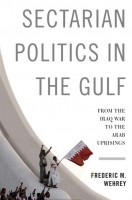 Author: Frederic M. Wehray
Author: Frederic M. Wehray
Publisher: Columbia University Press – 328 p-ages
Book Review by: Sonu Chandiram
What are the roots of the Shia-Sunni tensions that have dominated the Middle East region in recent years? This book investigates the thoughts and actions of these two major adherents of Islam and their divide; and discusses the causes and effects of the conflicts between them.
In researching for this book, the author conducted interviews with major Shia and Sunni leaders, activists, and opinion shapers in the area, as well as consulted diverse written sources.
It focuses on political events from the start of the invasion of Iraq in 2003 to the end of 2011. It identifies and discusses the principal factors that exacerbated or reduced sectarian tensions in Bahrain, Kuwait and Saudi Arabian.
Among others, those factors are:
- Clerical establishments
- Contagion effect of external regional events such as the 2006 Lebanon conflict, the Arab uprisings, the violent Iraq war, and Syria’s civil war
- Domestic political institutions
- The media
With a dozen chapters including the Conclusion, this is a four-part book in which Wehrey first looks at the roots of sectarianism in Part I; then discusses particular situations and events in Bahrain in Part II, Saudi Arabia in Part III, and Kuwait in Part IV.
The roots of sectarianism in these three countries can be found in:
- Governance, society, and identity in the Gulf, and
- The long shadow of the Iranian Revolution.
In the section on Bahrain, the author looks at, among other things:
- Debating participation: the Bahraini Shia and regional influences, and
- Sectarian balancing: the Bahraini Sunnis and a polarized parliament.
Then Wehrey moves on to Saudi Arabia, discussing:
- Loyalties under fire: the Saudi Shia in the shadow of Iraq
- Under siege: the Salafi and regime counter-mobilization, and
- Waving Uthman’s Shirt: Saudi Arabia’s sectarian Spring.
Lastly, the author takes a look at the situation in Kuwait, focusing on:
- Renegotiating a ruling bargain: the Kuwaiti Shia
- Tilting toward repression: the Sunni opposition and the Kuwaiti regime, and
- A balancing act goes awry: sectarianism and Kuwait’s mass protests.
In discussing the causes of sectarianism in his Introduction, Frederic Wehrey points out: “there has been no shortage of efforts in the Arab world to diagnose its root causes.” He writes that many commentators say that sectarianism is the product of meddling by “foreign, extra-regional parties” such as Iran, for example.
Aside from Iran, the United States and Israel have also frequently been cited by many as “instigators” of recurrent tensions in the region.
Domestic sources, especially in the media (e.g. satellite television and social sites such as Twitter) and in the political arena, have also been blamed for sectarianism, the author points out.
Frederick M. Wehray is a senior associate in the Middle East Program at the Carnegie Endowment for International Peace. He is a specialist in the politics of the Persian Gulf, and his articles and commentary have appeared in the New York Times, Foreign Affairs, and Foreign Policy. He holds a doctorate in international relations from St, Anthony’s College, Oxford University. He has traveled extensively in the region and met with the most important political figures in Bahrain, Kuwait, and Saudi Arabia.







